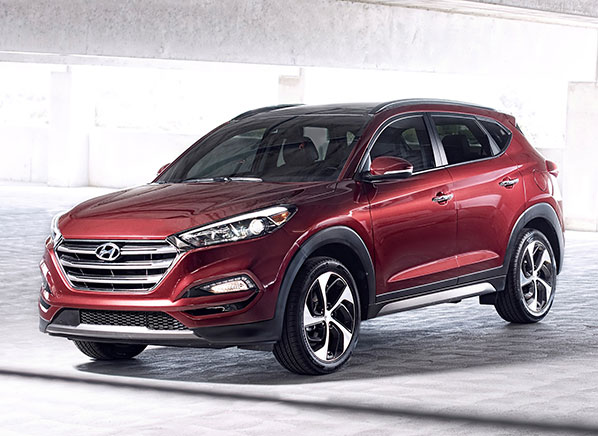By Shari Prymak
2016 Hyundai Tucson - The Hyundai Tucson has always been a perfectly good compact crossover, and, more than anything else, an excellent buy for the money. The new 2016 Tucson, however, aims to be far more than a value proposition. With improvements in styling, ride quality, fuel economy, safety, and equipment, Hyundai is looking to make the Tucson a real leader of the compact crossover segment.
Both inside and out, the Tucson is a rather well-designed crossover. The interior surfaces are covered in high quality soft materials in all the right places. The controls are well laid out and easy to operate, with a good assortment of buttons and knobs to compliment the touchscreen system. On the outside, the Tucson receives many of the styling cues from the Santa Fe Sport, giving it a handsome, tidy appearance, even though it hardly looks any smaller.
Hyundai has done a commendable job of giving the Tucson a well-sorted feel out on the road. Whether it's being thrown into onramps, or just settling down for a long freeway ride, the Tucson feels planted, secure, and properly comfortable. It's quiet as well, with little noticeable engine or road noise in the cabin while on the move.
My test car came equipped with the standard, 2.0L, naturally-aspirated engine and 6-speed automatic transmission. This drivetrain may be low on performance, but I still prefer it over the optional 1.6L, turbocharged engine and 7-speed dual-clutch gearbox. It's cheaper to buy outright, and the far less complicated design will make it cheaper to service over the long-haul as well. The turbo/dual-clutch drivetrain combo may offer better performance, but it's a highly complex arrangement mainly designed to achieve maximum fuel efficiency numbers on a spec sheet. In the real world, it really isn't that much more efficient, nor is it that refined, so why bother with the added expense and complication?
In terms of pricing, the Tucson isn't quite the value leader it once was. MSRPs start at a still reasonable $24,399 for a 2.0L, front-wheel drive model, and maxes out at a rather absurd $39,599 for the 1.6L Ultimate with all-wheel drive. Even though prices are up, the Tucson still offers a lot equipment for the money. My pick would be the 2.0L Luxury, which, for an MSRP of $33,099, offers heated front and rear seats trimmed in leather, heated steering wheel, navigation, an enormous panoramic sunroof, and most of the latest safety technologies.
The Tucson has enough going for it to stand its ground against its equally strong competitors like the Honda CR-V, Mazda CX-5, Toyota RAV4, Nissan Rogue, and Ford Escape. Still, a stronger case could be made had Hyundai stuck with the sharp price advantage it once had over its competitors. Let's hope that Hyundai throws in some of its incredible incentives soon to make the Tucson the solid buy it deserves to be.

